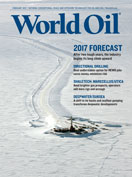Issue: February 2017
Special Focus
After two years of spending declines, North American E&Ps are set to increase capex during 2017, while international outlays are set to fall for a third consecutive year.
The eight-year regulatory nightmare in Washington has ended for the U.S. upstream industry, now that former President Barack Obama is gone. The new administration of President Donald Trump is carving out a much friendlier regime for hydrocarbon development.
The vast number of shale oil operators in the U.S. combined to act as unwilling swing producers during 2016, with the medium-to-small operators scrambling to survive the downturn. Marketed gas production dropped slightly, compared to last year.
Operators continued to idle rigs in the U.S. during 2016. The average U.S rotary rig count for 2016 was just 525 units, a 46.3% decline in activity compared to the previous year’s average of 977. Starting in Jan. 2016, the average monthly rig count dropped four times, before bottoming in May at 407.
The total number of active, producing oil wells in the U.S. dropped 2.7% last year. In spite of increased activity in the second half of the year, World Oil’s forecast data show the total number of active oil wells in the U.S. declined to 578,167 from 594,281.
The two-year oil price decline, and resulting plunge in activity and downsizing of assets and personnel by industry companies, appears to be over. Now, the industry is preparing to get back to work. A combination of OPEC’s quota deal in late 2016, along with lower North American oil production, service/supply cost reductions, high-grading of prospects by operators, and operational efficiencies, has done much to prop up oil prices and encourage a rebound in activity.
The number of producing gas wells in the U.S. slipped 1.5% last year, from 502,251 to 494,806, as the country’s output retreated from a peak of 91.7 Bcfd in April 2015 to 89.3 Bcfd in 2016.
According to the U.S. Energy Information Administration (EIA), U.S. crude oil and lease condensate proved reserves dropped 4.7 Bbbl in 2015. This represents an 11.8% decline, from 39.9 Bbbl to 35.2 Bbbl. This was the first drop in crude oil and lease condensate reserves since 2008.
Last year will be remembered for its stark contrasts in global production rates, with North America absorbing the largest loss, while the Middle East and Russia chalked up big gains. It remains to be seen how OPEC’s quota deal in December will alter the rules of the game.
One of the longest, most challenging periods in Canadian oil patch history appears to be drawing to a close. For the first time in three years, optimism is in the air for the country’s beleaguered producers.
Features
In a program that already totals four extended-reach wells, a major operator used a dual-reamer BHA solution to reduce rig time and costs.
Rigs, deals up amid brighter gas prospects
Reduced commodity prices have eliminated many options to improve deepwater project economics. Seafloor boosting, as an enabling technology for tie-back developments, has emerged as the most effective means to achieve, and sustain, economic flowrates from new discoveries. However, these tie-backs require different considerations than recently installed, hub-based, seafloor boosting systems, and require a unique approach and new technologies.
With a dense population and, therefore, a growing energy demand, Southeast Asia relies heavily on the oil and gas industry. This urgency has given rise to the region’s E&P efforts during an industry downturn, as producers have been forced to contend with low prices and aging fields.
The fourth Eastern Mediterranean Gas Conference (EMGC) is being held at Hilton Cyprus in Nicosia, Cyprus, March 14-15. The event venue is conveniently located, allowing easy access to some of the capital city’s main attractions, such as the city center, the Old City and the modern business district.
Columns
The drama of waning IOCs
Global oil and gas M&As in the current, challenging market
North America climbs out of its historical hole
Sometimes B-to-A is the right path
A better day
Outside the box
Ken Havlinek: Going for it
Saudi Arabia is back!
BOEM’s effort to protect taxpayers could stress GOM independents
Quid pro quo
News & Resources
World of oil & gas
Industry at a glance
People in the industry
Companies in the news
New products and services



